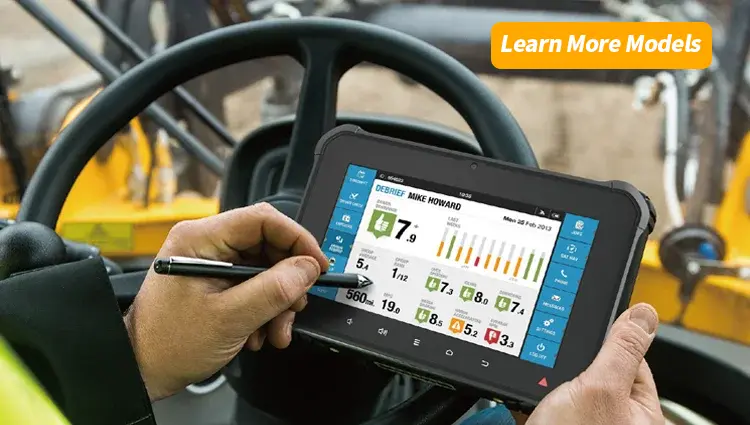Telematics: The Ultimate Solution for Skyrocketing Fuel Costs
The pervasive issue of escalating fuel costs presents a formidable challenge for businesses reliant on fleet operations. The silent culprits—inefficient driving habits and suboptimal routes—conspire to deplete budgets, leaving fleet managers in a precarious position. From excessive idling to aggressive acceleration and speeding, these seemingly minor missteps accumulate, inflicting substantial damage on the bottom line. However, a beacon of hope emerges in the form of telematics-powered insights, offering a comprehensive solution to mitigate these challenges and usher in an era of enhanced fuel efficiency and sustainability.
The Unseen Drain: How Driving Habits Impact Your Budget
Many fleet operators are acutely aware of fluctuating fuel prices, but the insidious impact of driver behavior often remains an underestimated factor in overall fuel consumption. Consider the following:
- Excessive Idling: Every minute a vehicle idles unnecessarily, fuel is being consumed without any productive movement. This is particularly prevalent in delivery operations where drivers might wait at loading docks or make frequent stops. Research consistently shows that idling for more than 10 seconds uses more fuel than restarting the engine. Over an entire fleet and a full year, this seemingly small waste can amount to thousands of dollars in lost fuel.
- Aggressive Driving: This encompasses a range of behaviors including rapid acceleration, hard braking, and speeding. Each of these actions forces the engine to work harder, demanding more fuel. Aggressive driving also leads to increased wear and tear on vehicle components, such as brakes and tires, further contributing to operational costs.
- Unplanned Detours and Inefficient Routes: Without proper route planning and real-time navigation, drivers can easily take longer, less efficient paths. This not only burns more fuel but also increases journey times, impacting productivity and potentially delaying deliveries. Even slight deviations from optimal routes, when multiplied across an entire fleet’s daily operations, result in significant wasted mileage and fuel.
- Lack of Proactive Maintenance: While not directly a driving habit, neglected vehicle maintenance can severely impact fuel efficiency. Underinflated tires, dirty air filters, and poorly maintained engines all contribute to increased fuel consumption. Without a system to monitor and address these issues proactively, fleets can unknowingly be operating at a sub-optimal efficiency level.
These factors, often overlooked or difficult to track manually, collectively contribute to what can be described as a “silent drain” on a fleet’s financial resources. The challenge lies in identifying these inefficiencies systematically and implementing strategies to correct them.
Telematics: Your Strategic Ally in Fuel Management
The good news is that solutions exist, and they are increasingly sophisticated and accessible. Telematics stands out as the most powerful tool in a fleet manager’s arsenal for tackling fuel inefficiency head-on. Telematics systems integrate GPS technology with onboard diagnostics to collect and transmit data on vehicle location, speed, engine performance, and driver behavior in real-time.
Here’s how telematics transforms fuel management:
Real-time Monitoring and Data Collection
The foundation of effective fuel management is accurate data. Telematics devices, installed in each vehicle, continuously monitor a wealth of parameters. This includes:
- Vehicle Speed: Tracking speed allows managers to identify instances of speeding, which is a significant contributor to higher fuel consumption.
- Idling Duration: The system can pinpoint exactly when and for how long a vehicle is idling, providing concrete data to address this issue.
- Harsh Braking and Acceleration: These events, indicative of aggressive driving, are logged, offering insights into driver behavior that can be refined.
- Engine RPM and Fuel Consumption: More advanced telematics systems can directly read fuel consumption data from the vehicle’s engine control unit (ECU), providing precise measurements of fuel burn rates.
- Geofencing and Route Adherence: By setting up virtual boundaries (geofences) and pre-defined routes, managers can monitor if drivers are adhering to planned paths and identify unauthorized detours.
This real-time data flow provides an unprecedented level of visibility into fleet operations. Instead of relying on anecdotal evidence or post-hoc analysis of fuel receipts, managers have actionable data at their fingertips, enabling immediate interventions and informed decision-making.

Empowering Drivers Through Coaching
Data without action is merely information. The true power of telematics lies in its ability to translate raw data into actionable insights that can be used for driver coaching. When specific instances of inefficient driving behaviors are identified, fleet managers can:
- Provide Personalized Feedback: Instead of generic warnings, drivers can receive tailored feedback based on their individual driving patterns. For example, a driver might be informed about specific routes where they idled excessively or instances of harsh braking.
- Set Measurable Goals: With baseline data, managers can work with drivers to set specific, achievable goals for improving fuel efficiency, such as reducing idling time by a certain percentage or decreasing the number of harsh braking events per trip.
- Implement Gamification and Incentives: Some companies use telematics data to create friendly competitions among drivers, rewarding those who demonstrate the most significant improvements in fuel-efficient driving. This can motivate drivers to adopt better habits.
- Offer Targeted Training: If a pattern of specific inefficient behaviors emerges across multiple drivers, it might indicate a need for broader training initiatives focusing on defensive driving techniques, economic acceleration, and efficient gear shifting.
By empowering drivers with knowledge and tools to improve, telematics fosters a culture of responsibility and efficiency within the fleet. It shifts the focus from punitive measures to proactive improvement, benefiting both the driver and the company.
Smart Route Optimization: Beyond Driving Habits
While driver behavior is a critical component of fuel efficiency, the routes vehicles take are equally important. Even the most efficient driver will consume more fuel on a poorly planned, longer, or congested route. Telematics solutions, especially when integrated with advanced mapping and logistics software, offer sophisticated route optimization capabilities:
- Shortest and Most Efficient Paths: Route optimization algorithms consider various factors beyond just distance, including real-time traffic conditions, road types, speed limits, and even vehicle-specific parameters (e.g., height or weight restrictions). This ensures that the generated routes are not only the shortest but also the most fuel-efficient.
- Multi-Stop Planning: For delivery and service fleets, optimizing multi-stop routes is crucial. Telematics-powered systems can sequence stops in the most logical order, minimizing backtracking and unnecessary mileage.
- Dynamic Re-routing: Unexpected events like road closures, accidents, or sudden traffic jams can derail even the best-laid plans. Advanced telematics systems can provide dynamic re-routing capabilities, automatically suggesting alternative paths to avoid delays and maintain efficiency.
- Load Balancing and Vehicle Utilization: Some sophisticated systems can also assist in optimizing load distribution across the fleet, ensuring that vehicles are used to their full capacity, reducing the number of trips required and thus saving fuel.
By minimizing unnecessary miles, reducing travel time, and avoiding congestion, smart route optimization directly translates into significant fuel savings. It also enhances overall operational efficiency, leading to faster delivery times and improved customer satisfaction.
Beyond Fuel: The Broader Benefits of Telematics
While fuel efficiency is a primary driver for adopting telematics, the benefits extend far beyond direct cost savings on gasoline or diesel. Implementing a robust telematics solution also contributes to:
- Enhanced Safety: Monitoring driving behavior helps identify risky habits, allowing managers to intervene and promote safer driving. This reduces the likelihood of accidents, which in turn lowers insurance premiums, repair costs, and downtime.
- Improved Vehicle Maintenance: Telematics can provide insights into vehicle health, alerting managers to potential mechanical issues before they lead to breakdowns. This enables proactive maintenance, reducing costly roadside repairs and extending vehicle lifespan.
- Increased Productivity: Optimized routes, reduced idling, and efficient driving all contribute to getting more done in less time, directly boosting the productivity of drivers and the entire fleet operation.
- Better Customer Service: Faster and more reliable deliveries, a direct result of route optimization and efficient operations, lead to higher customer satisfaction. Real-time tracking also allows for accurate ETAs, improving communication with clients.
- Sustainability and Green Initiatives: By reducing fuel consumption and emissions, telematics directly supports corporate sustainability goals and helps businesses reduce their carbon footprint. This is increasingly important for brand image and compliance with environmental regulations.
- Theft Recovery: In the unfortunate event of vehicle theft, the GPS tracking capabilities of telematics systems significantly increase the chances of recovery.
Who Stands to Gain the Most?
Telematics solutions are not just for large corporations. They offer significant value to a diverse range of businesses:
- Fleet Managers: For those directly responsible for the daily operations, maintenance, and performance of a fleet, telematics provides the data and tools necessary to make informed decisions and achieve operational excellence.
- Logistics Companies: In an industry where efficiency and timely deliveries are paramount, telematics is indispensable for optimizing routes, managing drivers, and ensuring cost-effective transportation of goods.
- Businesses with Delivery Operations: From food delivery services to retail businesses with their own delivery fleets, reducing fuel costs and improving delivery efficiency can directly impact profitability and customer satisfaction.
- Construction Companies: Managing heavy machinery and vehicles on various job sites, often in challenging terrains, benefits immensely from telematics for asset tracking, utilization, and maintenance scheduling.
- Field Service Businesses: Companies with technicians or service personnel traveling to multiple locations can use telematics to optimize schedules, track progress, and improve response times.
Taking the Leap: Investing in Your Fleet’s Future
The current economic climate, characterized by volatile fuel prices and increasing operational pressures, makes the adoption of telematics an imperative rather than an option. The initial investment in a telematics system is quickly offset by the substantial, ongoing savings on fuel, maintenance, and improved productivity.
Embracing telematics means taking control of your fuel expenses, transforming inefficiencies into opportunities for growth, and building a more sustainable and profitable fleet operation. It’s about empowering your team with insights, optimizing every mile, and driving efficiency together. The time to act is now.
Are you ready to unlock significant savings and boost the performance of your fleet?









